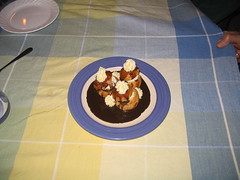
IMG_0471
Originally uploaded by wanderingcoyote.
So here is a shot of the dessert I made on Saturday night. The profiteroles (choux) are filled with orange-spiked whipped cream and a Grand Marnier ganache was poured over the top. The clotted cream I piped out with a star tip on the top of each profiterole and an extra few rosettes decorate the plate. I made something similar to this my first time doing dessert for the restaurant, way back in October.
Clotted cream is amazing stuff; I sweetened this with a bit of sugar and added some Grand Marnier to it as well. The combination of orange and chocolate is divine, and cream of any consistency is an amazing addition to any dessert.

6 comments:
My very english grandparents and mother are all covering their faces in embarassment right now, but just what is Devonshire clotted cream?
The desert looks delicious, by the way!
I got this description of clotted cream from www.joyofbaking.com.
"...A clotted cream produced commercially in Devon, Cornwall, and Somerset England. A thick, rich, yellowish cream with a scalded or cooked flavor that is made by heating unpasteurized milk until a thick layer of cream sits on top. The milk is cooled and the layer of cream is skimmed off. Clotted cream has 55-60 percent fat content and is so thick it does not need whipping. Traditionally served with scones and fruit."
You can go to places in Devon, Somerset, and Cornwall and have a cream tea, which is tea served with scones, jam, and a pot of clotted cream. You pile the clotted cream on the scone and put some jam on and chow down. It's decadently heavenly and my favourite thing to do when visiting this part of the world (I don't get there often enough, but my mom conveniently lives in Exeter, Devon and my godparents own property there). Also, at least in some parts of Devon, whenever you order a dessert at a pub or restaurant, or even when you get an ice cream cone, it's often served with a huge dollop of clotted cream. The colour and consistency varies depending on the cow (the Cornish cows produce a more yellowy clotted cream) and other factors. Sometimes the clotted cream is gooey, sometimes so thick you need a spoon to serve it.
Here, we can get it in small jars in some specialty shops in the cheese section, but it's really expensive. My mom says she's had it in other parts of England, and it just isn't the same. Even in England things are better in the west!
Mercy! That dessert looks so sinful that you should have presented it in an unmarked brown paper envelope!
Isabella is blushing, but looking at it at the same time!
Heavens!
Wow, your mum lives in England? Did she immigrate there, you here? Gotta be a story! (enquiring minds want to know!)
My grandparents and mother (and aunts) came here form Leigh, Lancashire shortly after the Big War (WW1). Unfortunately, they never made it back for a visit, although my mom kept in touch with a couple of her cousins until her passing a couple of years ago.
I now have to go to the local import food store and look for clotted cream (hopefully next to my favorite English food, Lyle's Golden Syrup!)
Oh my, I just drooled something fierce!
As a passionate cook, I love many of the recipes that you've posted; I look forward to giving some of your recommended ones a go, particularly if you have a favourite.
And in re: clotted cream, it is best out west, but famous creameries like Rhodda's now produce cartons that you can buy at delis (for example, here in Cambridge, near London) and it's pretty exceptional to have it in the comfort of your own home. Hmm, I suddenly crave scones... to the kitchen!
Stairs,
Thank you so much for stopping by. I hope no permanent damage was done to your computer by your drooling.
If you try anything, do let me know how it works out. I'm curious how baking might turn out over there considering the differences in available flours etc. When my mom moved over there 8 years ago, none of her Canadian recipes worked well. Chefs at my school, when I asked them about this, cited many different reasons, including the different flours, differences in egg size, and a vast difference in the quality of butter.
I shall now make my way over to your blog.
Post a Comment